CREAbooks
Our unconscious mind has the key
Hare Brain, Tortoise Mind – Guy Claxton
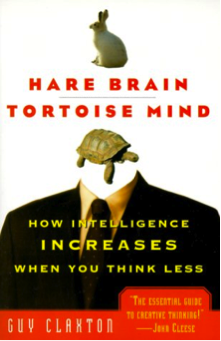 Guy Claxton describes in this book 2 ways of thinking: the sharp, crisp business thinking of the hare brain and the more contemplative thinking of the tortoise mind. As everything needs to go very fast, the hare brain seems to win always from the intuition of the tortoise mind. The book shows the opposite. Our best thinking happens in our unconscious. The tortoise mind cannot fail if we take inspiration and intuition into account.
Guy Claxton describes in this book 2 ways of thinking: the sharp, crisp business thinking of the hare brain and the more contemplative thinking of the tortoise mind. As everything needs to go very fast, the hare brain seems to win always from the intuition of the tortoise mind. The book shows the opposite. Our best thinking happens in our unconscious. The tortoise mind cannot fail if we take inspiration and intuition into account.
Slow – Carl Honoré
 At a certain moment in his life, Carl Honoré was busy with so many things and lived at a very high speed. He barely had time for his kids. At a certain moment, he saw the light and decided to do things different. He took time for the really important things of life. He found it in the slow movement and wrote a book about it. From slow food to slow sex to slow cities. Always looking for the right tempo, the ‘tempo giusto’. This book, which I read in Zell am See, inspired me to start with meditation.
At a certain moment in his life, Carl Honoré was busy with so many things and lived at a very high speed. He barely had time for his kids. At a certain moment, he saw the light and decided to do things different. He took time for the really important things of life. He found it in the slow movement and wrote a book about it. From slow food to slow sex to slow cities. Always looking for the right tempo, the ‘tempo giusto’. This book, which I read in Zell am See, inspired me to start with meditation.
Your senses are doors to creativity
The experience economy
 Beautiful book about the evolution from products to services and further to experiences. People want to have a good time and are willing to pay extra for a unique experience. Pine and Gilmore show how you can master such an experience. They also predict another trend: from experience to fulfillment. We will spend more money in the future to experiences which give fulfillment to our lives.
Beautiful book about the evolution from products to services and further to experiences. People want to have a good time and are willing to pay extra for a unique experience. Pine and Gilmore show how you can master such an experience. They also predict another trend: from experience to fulfillment. We will spend more money in the future to experiences which give fulfillment to our lives.
Balance left- and right hemisphere
A Whole New Mind – Dan Pink
 Dan Pink states that our left brain is not enough anymore to play a role in a fast changing world. It is important to develop our right brain better. Therefore, more attention is needed for humor, games, emotional intelligence, spiritual fulfillment, empathy, design, stories and context. Cool book with lots of examples. This way we can also create products and services which are not easy to copy.
Dan Pink states that our left brain is not enough anymore to play a role in a fast changing world. It is important to develop our right brain better. Therefore, more attention is needed for humor, games, emotional intelligence, spiritual fulfillment, empathy, design, stories and context. Cool book with lots of examples. This way we can also create products and services which are not easy to copy.
how to think like Leonardo da Vinci – Michael J. Gelb
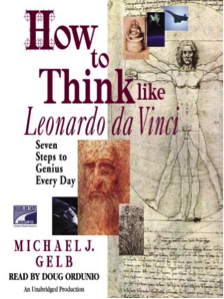 Leonardo da Vinci hanteerde 7 principes om tot al zijn schilderijen, beeldhouwwerken en ontwerpen te komen. Hij gebruikte daarbij zijn beide hersenhelften. Zo kon hij met wetenschappelijke nauwkeurigheid de anatomie van de mens bestuderen maar experimenteerde hij dan weer met verschillende soorten verf en oefende hij constant zijn zintuigen. Hij was heel nieuwsgierig en leerde omgaan met onzekerheid. Hij trainde zowel zijn lichaam als zijn geest en hield er van om in detail in te zoemen op een gebeurtenis maar tegelijkertijd het overzicht en gevoel voor context te behouden. Als je slechts tijd heb om 1 boek uit Creaboeken te lezen, zou ik deze aanraden.
Leonardo da Vinci hanteerde 7 principes om tot al zijn schilderijen, beeldhouwwerken en ontwerpen te komen. Hij gebruikte daarbij zijn beide hersenhelften. Zo kon hij met wetenschappelijke nauwkeurigheid de anatomie van de mens bestuderen maar experimenteerde hij dan weer met verschillende soorten verf en oefende hij constant zijn zintuigen. Hij was heel nieuwsgierig en leerde omgaan met onzekerheid. Hij trainde zowel zijn lichaam als zijn geest en hield er van om in detail in te zoemen op een gebeurtenis maar tegelijkertijd het overzicht en gevoel voor context te behouden. Als je slechts tijd heb om 1 boek uit Creaboeken te lezen, zou ik deze aanraden.
use your head – Tony Buzan
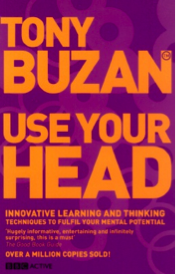 A beautiful way to keep balance between your left and your brain is mindmapping, invented by Tony Buzan. This technique which is easy to use, presents information in a way our brain likes. With keywords and images. From core to detail. By making the mindmap first, you structure the information and by exercising, you can remember the information very long. Mindmapping also helps for creativity, you can use it during brainstorms where you can place new ideas around a central question. This helps you to make easily associations as you have the overview on one page.
A beautiful way to keep balance between your left and your brain is mindmapping, invented by Tony Buzan. This technique which is easy to use, presents information in a way our brain likes. With keywords and images. From core to detail. By making the mindmap first, you structure the information and by exercising, you can remember the information very long. Mindmapping also helps for creativity, you can use it during brainstorms where you can place new ideas around a central question. This helps you to make easily associations as you have the overview on one page.
Personal aspects of creativity
The 10 faces of Innovation – Tom Kelley
 Tom Kelley explains in this book how innovation has 10 faces and how important it is to have different roles in your organization. The anthropologist, who observes what and how people do things; The experience architect creates experiences for the consumer, the hurdler is taking every obstacle and the cross-pollinator connects people out of different networks. You don’t have to have all these roles separately in an organization, often they can be combined in one person. It gives you an idea which disciplines you still need to master in your organization.
Tom Kelley explains in this book how innovation has 10 faces and how important it is to have different roles in your organization. The anthropologist, who observes what and how people do things; The experience architect creates experiences for the consumer, the hurdler is taking every obstacle and the cross-pollinator connects people out of different networks. You don’t have to have all these roles separately in an organization, often they can be combined in one person. It gives you an idea which disciplines you still need to master in your organization.
The 7 habits of highly effective people – Stephen Covey
 Brilliant book from Stephen Covey about the habits that are important for you to live and work effective but also to become more happy. Know that you are the programmer of your life by writing and executing your own program. You learn in this book also how you can do that together with others. How do you create win-win situations? How can you place yourself in the reference frame of somebody else and how do you create synergies? Finally Covey let you find a balance between the physical, the mental, the social and the spiritual.
Brilliant book from Stephen Covey about the habits that are important for you to live and work effective but also to become more happy. Know that you are the programmer of your life by writing and executing your own program. You learn in this book also how you can do that together with others. How do you create win-win situations? How can you place yourself in the reference frame of somebody else and how do you create synergies? Finally Covey let you find a balance between the physical, the mental, the social and the spiritual.
Drive – Dan Pink
 You can only motivate people if you motivate them intrinsically. External motivation like money does not work. The secret of pleasure in your life and work is in your intrinsic motivation. It is your deepest wish to create and to contribute to things that make a difference. He refers to Tom Sawyer who is painting a fence in the novel of Marc Twain. Boring job but Tom succeeds to let it look so cool that his friends are paying him to be able to paint it themselves.
You can only motivate people if you motivate them intrinsically. External motivation like money does not work. The secret of pleasure in your life and work is in your intrinsic motivation. It is your deepest wish to create and to contribute to things that make a difference. He refers to Tom Sawyer who is painting a fence in the novel of Marc Twain. Boring job but Tom succeeds to let it look so cool that his friends are paying him to be able to paint it themselves.
Inspiration en Brainstorms
The Idea Book – Fredrik Härén
 In this book, Fredrik Härén, Swedish author and excellent keynote speaker, shows how to break patterns, how you unlearn what you have learned, how innovation is the result of things which annoy you, how you mix things which cannot be mixed and how you really think outside the box.
In this book, Fredrik Härén, Swedish author and excellent keynote speaker, shows how to break patterns, how you unlearn what you have learned, how innovation is the result of things which annoy you, how you mix things which cannot be mixed and how you really think outside the box.
This book contains also a lot of empty space for your own ideas and does not fill in everything. It leaves room for your own creativity. Marvellous to read, not necessary to finish in one time. You can read it in bits and pieces as well.
The Art of Innovation – Tom Kelley
 Tom Kelley explains how Ideo, one of the most important design companies in the world, has built a culture of creativity and brainstorming. An environment where a lot of prototypes are built and where people learn very fast from their mistakes. Where there is attention for a inspiring workplace which stimulates to think outside the box.
Tom Kelley explains how Ideo, one of the most important design companies in the world, has built a culture of creativity and brainstorming. An environment where a lot of prototypes are built and where people learn very fast from their mistakes. Where there is attention for a inspiring workplace which stimulates to think outside the box.
Creativiteitstools
Creativity today – Igor Byttebier and ramon vullings
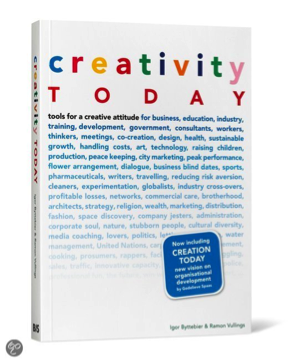 Very good book about creativity with lots of practical examples and tasks. If you can withstand the seduction to look at the solution at the end of the book, you will find some nice challenges.
Very good book about creativity with lots of practical examples and tasks. If you can withstand the seduction to look at the solution at the end of the book, you will find some nice challenges.
How do you sell an idea?
made to stick - Chip & Dan Heath
 The Heath brothers did an investigation why sayings, fables and other information has been transferred from generation to generation. The reason is that they always contain the same elements: most often it are stories which are simple, unexpected, concrete, credible and with a certain emotion. They call it the success factor (Simple, Unexpected, Concrete, Credibel, Emotional, Story). If you use certain of these elements in your presentation, slideshare or blog, more chance that people are not only going to like it but also will remember it much longer.
The Heath brothers did an investigation why sayings, fables and other information has been transferred from generation to generation. The reason is that they always contain the same elements: most often it are stories which are simple, unexpected, concrete, credible and with a certain emotion. They call it the success factor (Simple, Unexpected, Concrete, Credibel, Emotional, Story). If you use certain of these elements in your presentation, slideshare or blog, more chance that people are not only going to like it but also will remember it much longer.
Purple Cow – Seth Godin
 Traditional marketing is dead. Shout loud that your product is the best amongst many others in a red ocean of comparable products? Good luck! But suppose there is somewhere a purple cow, much likely you have seen it. The same is true for your product or service. How can you make your product standing out in the crowd so it contains marketing in it? Seth Godin gives lots of tips in this book how to do this.
Traditional marketing is dead. Shout loud that your product is the best amongst many others in a red ocean of comparable products? Good luck! But suppose there is somewhere a purple cow, much likely you have seen it. The same is true for your product or service. How can you make your product standing out in the crowd so it contains marketing in it? Seth Godin gives lots of tips in this book how to do this.
Marketing outrageously – Jon Spoelstra
 Jon Spoelstra states that it is not only important to cut costs but that increasing your income is much more relevant. You can do that via smart marketing. In the book you can read quite some techniques how do that. The importance to be creative and to think about something what nobody else has thought. But also take risk and if needed to put your money on one big action rather than to spend it on nitty gritty stuff. Tell a story, get attention or make it exclusive.
Jon Spoelstra states that it is not only important to cut costs but that increasing your income is much more relevant. You can do that via smart marketing. In the book you can read quite some techniques how do that. The importance to be creative and to think about something what nobody else has thought. But also take risk and if needed to put your money on one big action rather than to spend it on nitty gritty stuff. Tell a story, get attention or make it exclusive.
Networking
the Conversity Model – Clo Willaerts
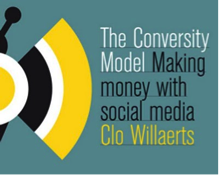 In het Conversity model Clo Willaerts talks about the role of social media in our companies. Most of our organizations are not paying a lot of attention on this still, let alone that they invest in it. This has to change urgently because a lot of people spend their time online. Interesting guide with quite some definitions of often used words and also understandable for non-specialists.
In het Conversity model Clo Willaerts talks about the role of social media in our companies. Most of our organizations are not paying a lot of attention on this still, let alone that they invest in it. This has to change urgently because a lot of people spend their time online. Interesting guide with quite some definitions of often used words and also understandable for non-specialists.
How to really use LinkedIn? – Jan Vermeiren
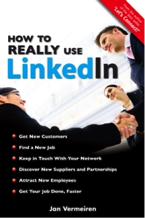 Jan Vermeiren shares a lot of tips which you can use for LinkedIn but also in real life. He specifically zooms in LinkedIn and how you can use this social medium in a smart way.
Jan Vermeiren shares a lot of tips which you can use for LinkedIn but also in real life. He specifically zooms in LinkedIn and how you can use this social medium in a smart way.
The Wisdom of Crowds – James Surowiecki
 In this book James Surowiecki proves with quite some examples that big groups are often smarter as a whole than the smartest guy or girl in the group, as long as the groups are diverse, decentralized and independent (not influenced by each other). This is true for problem solving but also for taking decisions. The story about the fair where people have to estimate the weight of an ox is brilliant. You would think that a merchant of cattle would have an advantage. It came out that the average of everybody together estimating the weight was almost exactly the weight of the ox.
In this book James Surowiecki proves with quite some examples that big groups are often smarter as a whole than the smartest guy or girl in the group, as long as the groups are diverse, decentralized and independent (not influenced by each other). This is true for problem solving but also for taking decisions. The story about the fair where people have to estimate the weight of an ox is brilliant. You would think that a merchant of cattle would have an advantage. It came out that the average of everybody together estimating the weight was almost exactly the weight of the ox.
Open Innovation – Henry Chesbrough
 Companies and organizations who still think they can do everything themselves are dead. The smartest people are not working for you. Chesbrough explains in this book how the open innovation funnel works. In an open innovation company, you generate an inflow of ideas of universities, start-up and other companies but also an outflow of concepts which you can not use yourself. Co-creation with the external world, based upon trust, enables you to innovate quicker and at lower cost. This means you can do more innovation with the same amount of people. An eye-opener for organizations which are still using the closed innovation model.
Companies and organizations who still think they can do everything themselves are dead. The smartest people are not working for you. Chesbrough explains in this book how the open innovation funnel works. In an open innovation company, you generate an inflow of ideas of universities, start-up and other companies but also an outflow of concepts which you can not use yourself. Co-creation with the external world, based upon trust, enables you to innovate quicker and at lower cost. This means you can do more innovation with the same amount of people. An eye-opener for organizations which are still using the closed innovation model.
How to win friends & influence people – Dale Carnegie
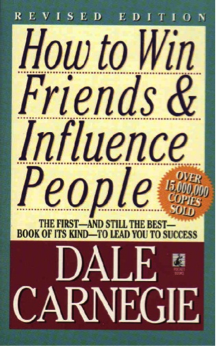 Do you mean that? A book from 1936 in your overview of creabooks? Sure, the book of Dale Carnegie is fantastic with a lot of networking tips. He explains how you can put yourself in the reference frame of the other person and how to use your emotional intelligence. A bit American but if he would still be alive, he would be one of the most famous TED speakers.
Do you mean that? A book from 1936 in your overview of creabooks? Sure, the book of Dale Carnegie is fantastic with a lot of networking tips. He explains how you can put yourself in the reference frame of the other person and how to use your emotional intelligence. A bit American but if he would still be alive, he would be one of the most famous TED speakers.
Innovatiecultuur van een organisatie
Who moved my cheese? - Spencer Johnson
 This story is about 4 mice: Sniff, Scurry, and 2 Littlepeople: The Littlepeople can be compared with human beings because they act and react like them. Every day the mice are looking for cheese which is always available at the same place. At a certain moment, there is no cheese. The mice are in panic. After some time, Sniff en Scurry start looking for new cheese whereas the Littlepeople continue to look at the same place hoping the cheese will be there again. It takes some time before they also start to look for new cheese. Beautiful story about change and the resistance to it.
This story is about 4 mice: Sniff, Scurry, and 2 Littlepeople: The Littlepeople can be compared with human beings because they act and react like them. Every day the mice are looking for cheese which is always available at the same place. At a certain moment, there is no cheese. The mice are in panic. After some time, Sniff en Scurry start looking for new cheese whereas the Littlepeople continue to look at the same place hoping the cheese will be there again. It takes some time before they also start to look for new cheese. Beautiful story about change and the resistance to it.
Our iceberg is melting – John Kotter / Holger Rathgeber
 A colony of penguins is told that the iceberg on which they live is melting. So it is good to look for another iceberg. Some penguins start immediately looking for a new one, other penguins believe that their iceberg won’t melt and try to convince everybody. Finally they all move to a new iceberg and make ‘looking for a new iceberg’ a habit. The elements of change in this book are coming from the other book of John Kotter: ‘Leading Change’, for me the best book ever about change.
A colony of penguins is told that the iceberg on which they live is melting. So it is good to look for another iceberg. Some penguins start immediately looking for a new one, other penguins believe that their iceberg won’t melt and try to convince everybody. Finally they all move to a new iceberg and make ‘looking for a new iceberg’ a habit. The elements of change in this book are coming from the other book of John Kotter: ‘Leading Change’, for me the best book ever about change.
Losing my virginity – Richard Branson
 Beautiful book about entrepreneurship and learning from your mistakes. Several times, Branson has put everything he had on the line to realize his dreams. ‘Screw it, let’s do it’ is one of his most famous sayings. That way he has realized a lot of beautiful things. Not only in business but also in private. In a balloon at high altitude, he learned what life is about.
Beautiful book about entrepreneurship and learning from your mistakes. Several times, Branson has put everything he had on the line to realize his dreams. ‘Screw it, let’s do it’ is one of his most famous sayings. That way he has realized a lot of beautiful things. Not only in business but also in private. In a balloon at high altitude, he learned what life is about.
Innovative workplaces
Shackleton’s way – Margot Morrell and Stephanie Capparell
 Ernest Shackleton is one of the important Antartic travelers. With the Endurance, his ship, he got stuck in the ice one winter in Antartica together with a complete crew. At that moment, you need to be creative if you want to survive. Shackleton shows in this book that leadershop and change often has to do with giving the example. Leaders also serve and are not afraid to bring tea to a sick sailor.
Ernest Shackleton is one of the important Antartic travelers. With the Endurance, his ship, he got stuck in the ice one winter in Antartica together with a complete crew. At that moment, you need to be creative if you want to survive. Shackleton shows in this book that leadershop and change often has to do with giving the example. Leaders also serve and are not afraid to bring tea to a sick sailor.
My organization is a jungle – Jef Staes
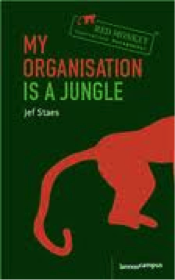 According to Joel Barker of the University of Maryland biodiversity origins not in the heart of the jungle but at the edge. Only where the forest has contact with other ecosystems (such as the sea) cross-fertilization takes place and creates new organisms. Jef Staes compares an organization with a jungle. New ideas are like red monkeys. You better arise them at the edge of the jungle before you show them to a bigger public. An organization needs to have a balance between creators (red monkeys), pioneers (protecting red monkeys), settlers (hunters) and followers. Each group is needed and in a healthy organization: there should be respect for red monkeys but also for the realism of a settler.
According to Joel Barker of the University of Maryland biodiversity origins not in the heart of the jungle but at the edge. Only where the forest has contact with other ecosystems (such as the sea) cross-fertilization takes place and creates new organisms. Jef Staes compares an organization with a jungle. New ideas are like red monkeys. You better arise them at the edge of the jungle before you show them to a bigger public. An organization needs to have a balance between creators (red monkeys), pioneers (protecting red monkeys), settlers (hunters) and followers. Each group is needed and in a healthy organization: there should be respect for red monkeys but also for the realism of a settler.
The Individualized Corporation – Sumantra Ghoshal & Christopher A. Bartlett
 Ghoshal & Bartlett talk about installing the reversed pyramid where people from the base can take their ideas further. They have a lot of feeling with what happens in the world and what the customers want. There is an evolution in the relationship between a manager and an employee from contract, compliance, constraint and control to support, discipline, stretch and trust. There is an unbelievable power when you reverse the hierarchical pyramid of your organization. This book was explained in a co-lecture by Professor Debackere (Louvain university) and myself during an Agoria gathering in 2011.
Ghoshal & Bartlett talk about installing the reversed pyramid where people from the base can take their ideas further. They have a lot of feeling with what happens in the world and what the customers want. There is an evolution in the relationship between a manager and an employee from contract, compliance, constraint and control to support, discipline, stretch and trust. There is an unbelievable power when you reverse the hierarchical pyramid of your organization. This book was explained in a co-lecture by Professor Debackere (Louvain university) and myself during an Agoria gathering in 2011.

